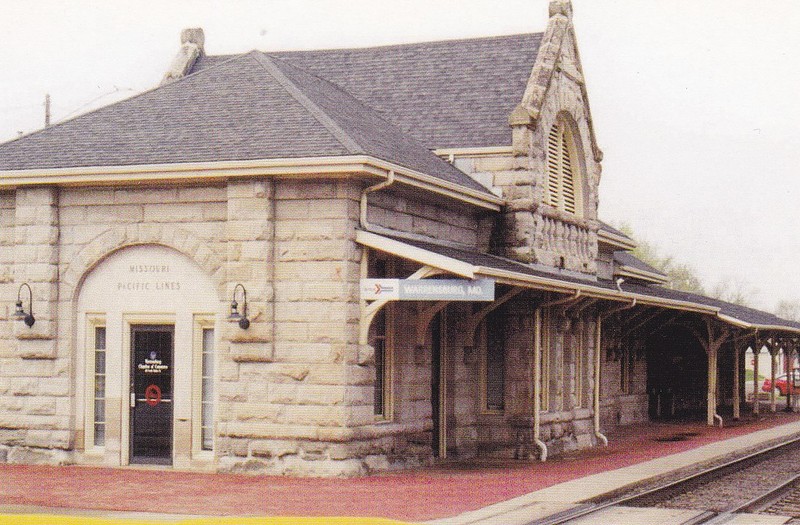Warrensburg Station (Chamber of Commerce)
Introduction
Text-to-speech Audio
Warrensburg developed as a trading center during the mid-nineteenth century, which inspired the Missouri Pacific Railroad to create a stop in the town for its new St. Louis to Kansas City (and beyond) rail line. The railroad offered an array of industries, from mining to farming, a chance to grow because of the expanded marketplace outside of Warrensburg. Indeed, the sandstone used to build the train station, among several other prominent buildings, came from a nearby quarry that benefited greatly from the railway. The location of the Warrensburg Station, not far from the Warrensburg Courthouse, speaks to the shift in commercial and government activity from the old Main Street corridor to the Holden Street corridor. Today, the building is home to the Warrensburg Chamber of Commerce.
Images
Warrensburg Station in Warrensburg, Missouri

Backstory and Context
Text-to-speech Audio
Now home to the Warrensburg Chamber of Commerce, the historic building originally opened in 1890 as the Warrensburg Station, which served the Missouri Pacific Railroad. Like numerous buildings constructed in west-central Missouri during the late nineteenth century, builders used sandstone from local quarries to construct the depot. The town's increasing success as a trading center inspired investors to create a stop in Warrensburg, and then the railway's arrival helped the city grow.
The area that evolved into Warrensburg stood initially as the home to the Osage and Kansa (Native American) nations. But, after the 1803 Louisiana Purchase and a series of treaties between 1808 and 1825, along with general westward expansionism, white settlers ultimately displaced the natives. By 1836, Warrensburg arose as an organized town (named after Revolutionary War veteran Martin Warren, who moved to the area in 1833).
Today, the Main Street corridor and the town's first permanent courthouse building speak to the original business and government center (Daniel Morgan Boone, son of Daniel Boone, served as one of the three commissioners to choose the site for the original courthouse building). Warrensburg's initial growth primarily resulted from its success as a mercantile community, a place for farmers to purchase supplies and sell goods. The success inspired investors to bring the railroad into Warrensburg as a stop between Kansas City and St. Louis. However, the historic railroad station did not get built near Main Street, but instead west of there along the Holden Street corridor.
The Pacific Railroad (renamed Missouri Pacific Railway in 1872) obtained a charger in 1849 to build a railroad from St. Louis to western Missouri, and they desired to lay tracks to the Pacific Ocean. Ground broke St. Louis in 1851 and, although the Civil War delayed its progress, reached Warrensburg by July 1864. The rail company built its first depot in 1865, which stood until February 1889 when a fire destroyed the structure. Consequently, they built the current, historic station. The placement of the depot east of the original downtown caused most businesses to open (or relocate) to lots near the Pacific Railroad and helped the town grow; the population grew from 900 to 3,000 between 1860 and 1870.
Moreover, the railroad's arrival cemented Warrensburg's place as an important trading center. Farmers and ranchers (along with ancillary businesses such as flour mills and slaughterhouses) could ship commodities to St. Louis, Kansas City, and other distant markets. Meanwhile, during the 1870s, mining operations north of town expanded, partly because of the extended markets the trains provided but also the increased population into west-central Missouri.
Warrensburg also gained a good reputation as a place of leisure, mainly due to nearby natural springs and lakes. Once treasured by Native Americans for its believed healing properties, the spring water served as the source of several lakes developed by William Purtle. He dammed one of the springs on his property during the late nineteenth century. The railway allowed him to ship the freshwater to cities across the nation. People also traveled to Warrensburg to enjoy the water in person. Indeed, Purtle built a lakeside hotel in 1884. In 1889, a ferry connected the Warrensburg Station to the lakeside hotel, which inspired developers to create several recreational establishments near the hotel from the 1890s through the 1920s.
The boom in population and business activity led Warrensburg to construct a new courthouse in the 1890s not far from the Warrensburg Station, cementing the commercial, social, and political shift from the Main Street corridor to the Holden Street corridor. Today, the building stands as the home to the Warrensburg Chamber of Commerce, but it serves as a reminder of the railroad's arrival and its significance.
Sources
"1864 July 4th Missouri Pacific Railroad Reaches Warrensburg, Missouri." Show Me The History: Johnson County & West-Central, Missouri." July 1, 2019. https://1973whsreunion.blogspot.com/2013/12/june-16-1864-sacramento-daily-union.html.
Nugent, Rachel and Alison Dunleavy. "Registration Form: Holden and Pine Streets Commercial Historic District." mostateparks.com. 2017. https://mostateparks.com/sites/mostateparks/files/Holden%20and%20Pine%20Sts%20Com%20HD.pdf.
Show-Me Regional Planning Commission. "Historical and Architectural Study of Residential Structures in Warrensburg, Missouri." Office of Historic Preservation. mostateparks.com. December 1983. https://mostateparks.com/sites/mostateparks/files/Warrensburg%20Res%20Report.pdf.
"Warrensburg, MO (WAR)." Amtrak Great American Stations Project. greatamericanstations.com. Accessed November 14, 2021. https://www.greatamericanstations.com/stations/warrensburg-mo-war/.
By TortugaRachel - Own work, CC0, https://commons.wikimedia.org/w/index.php?curid=18336919
